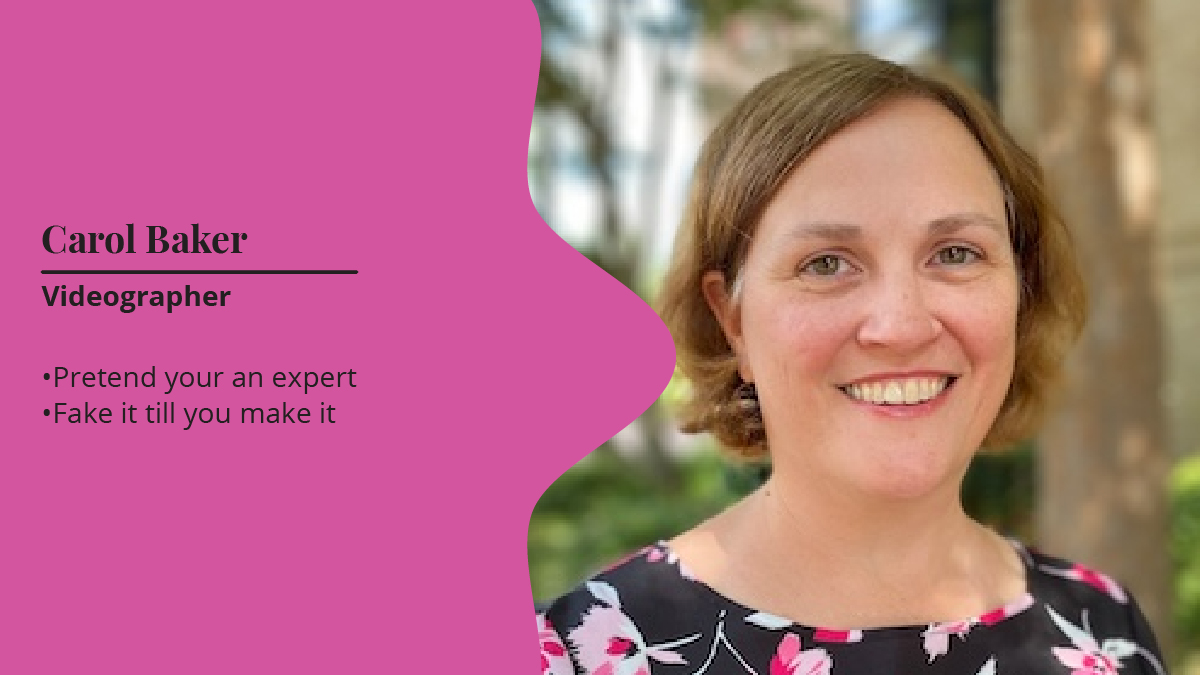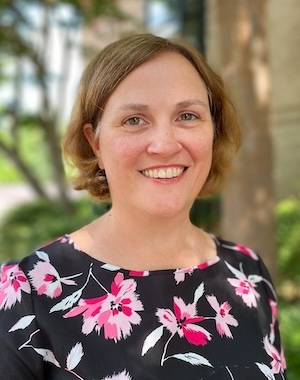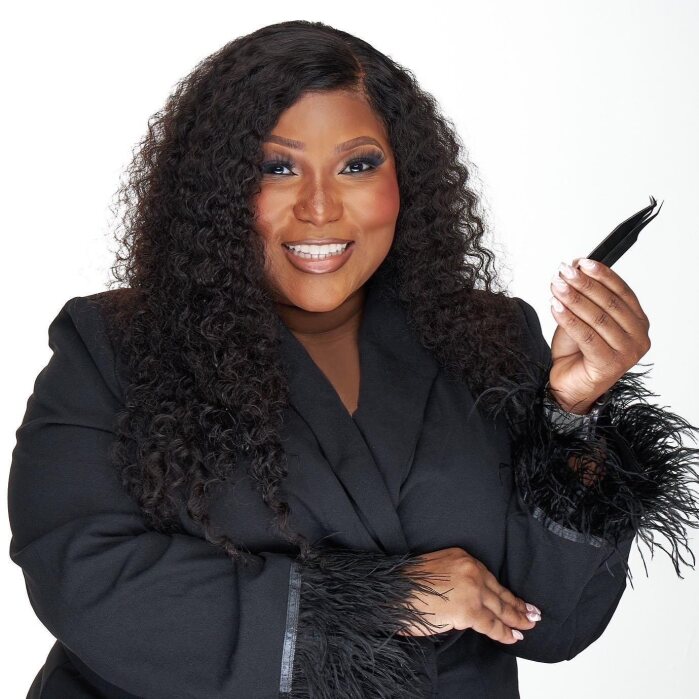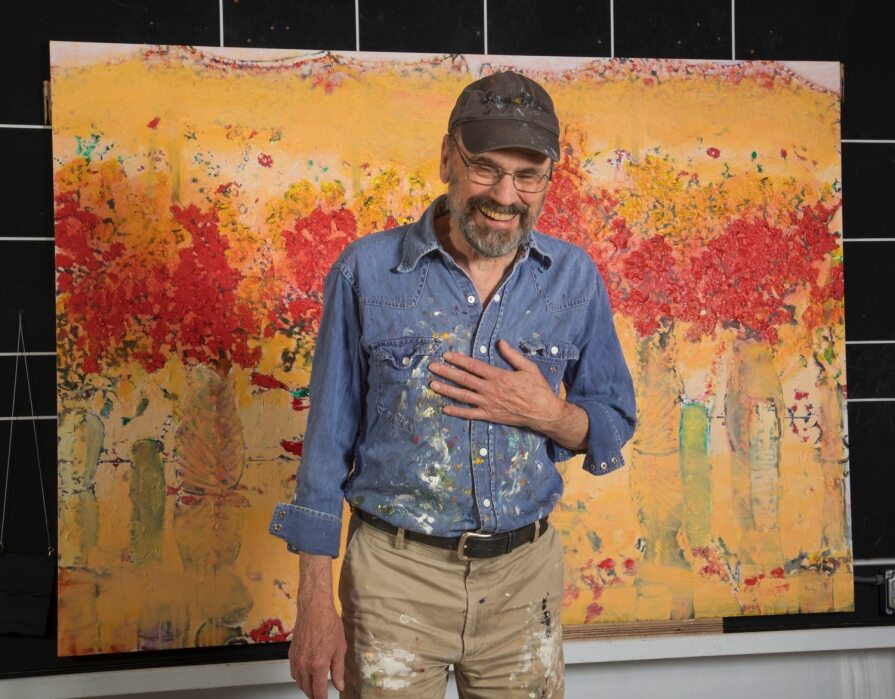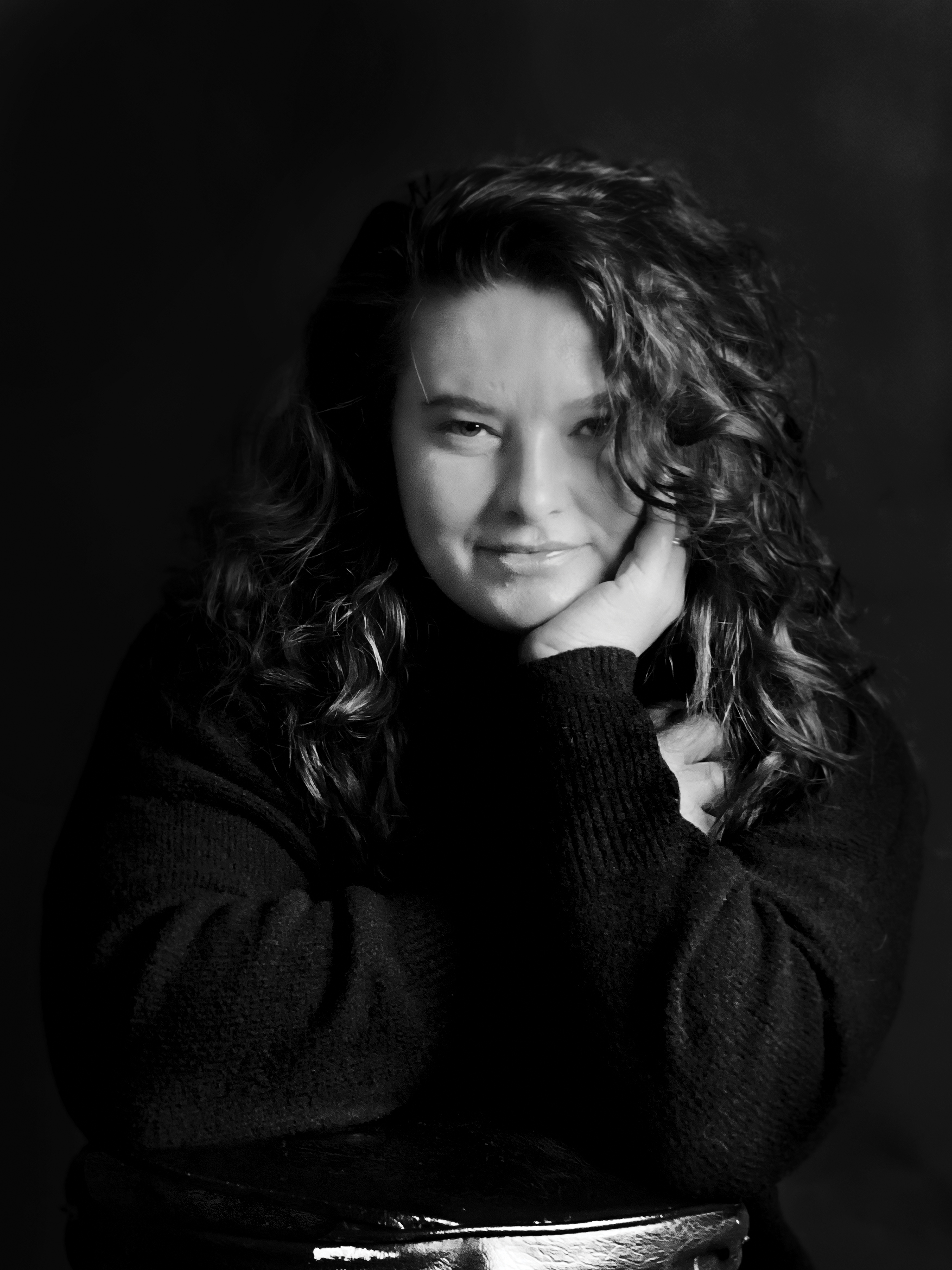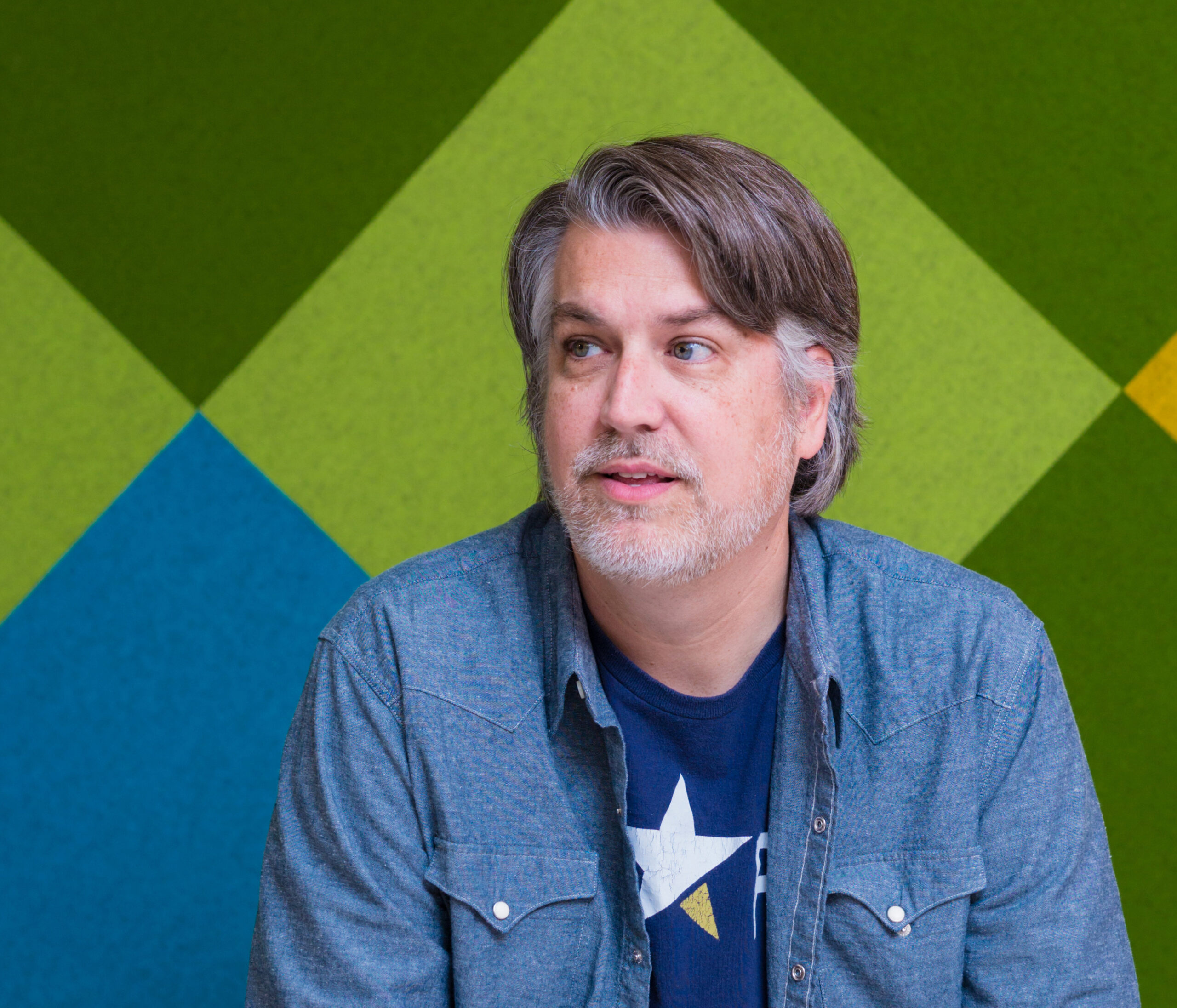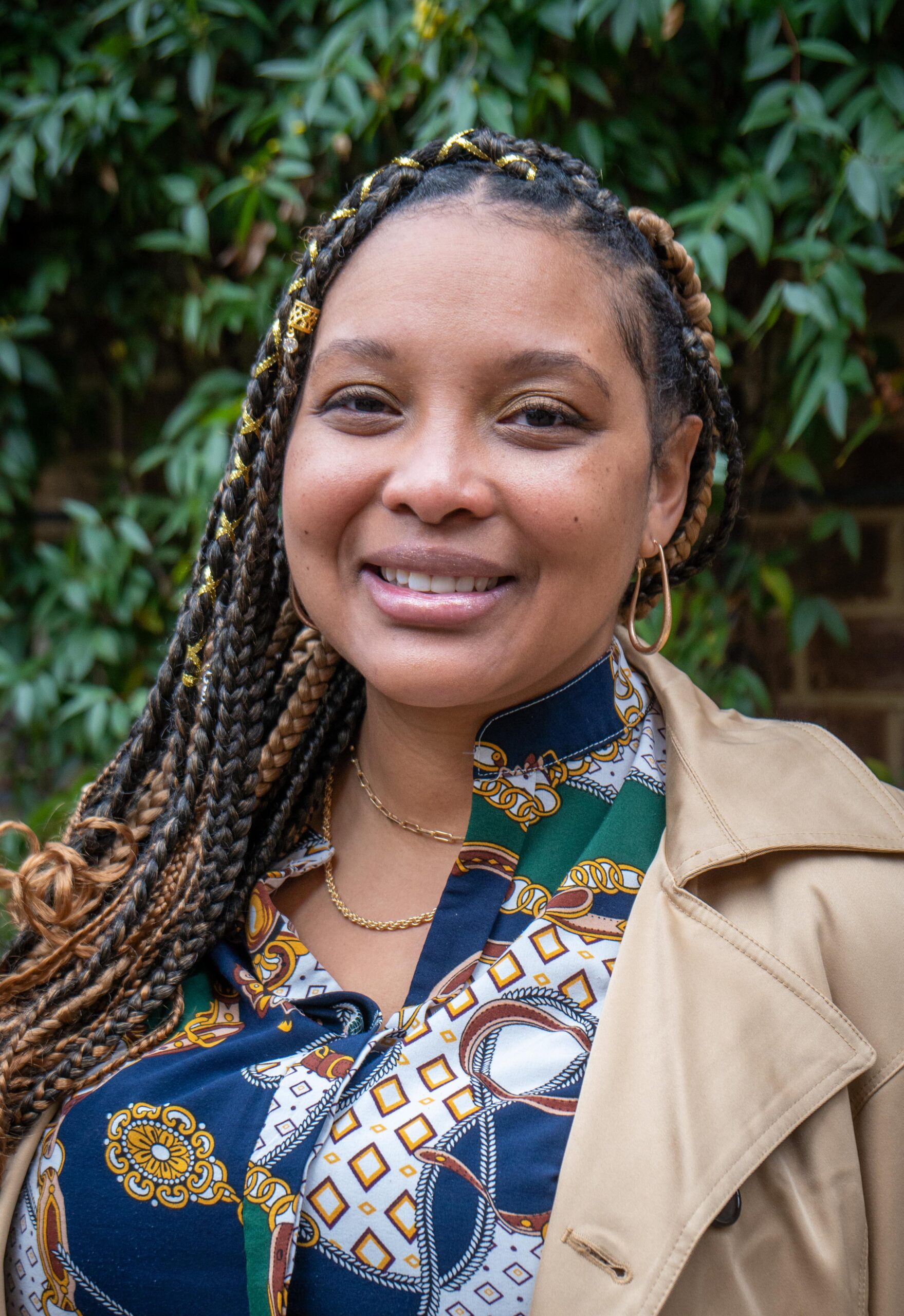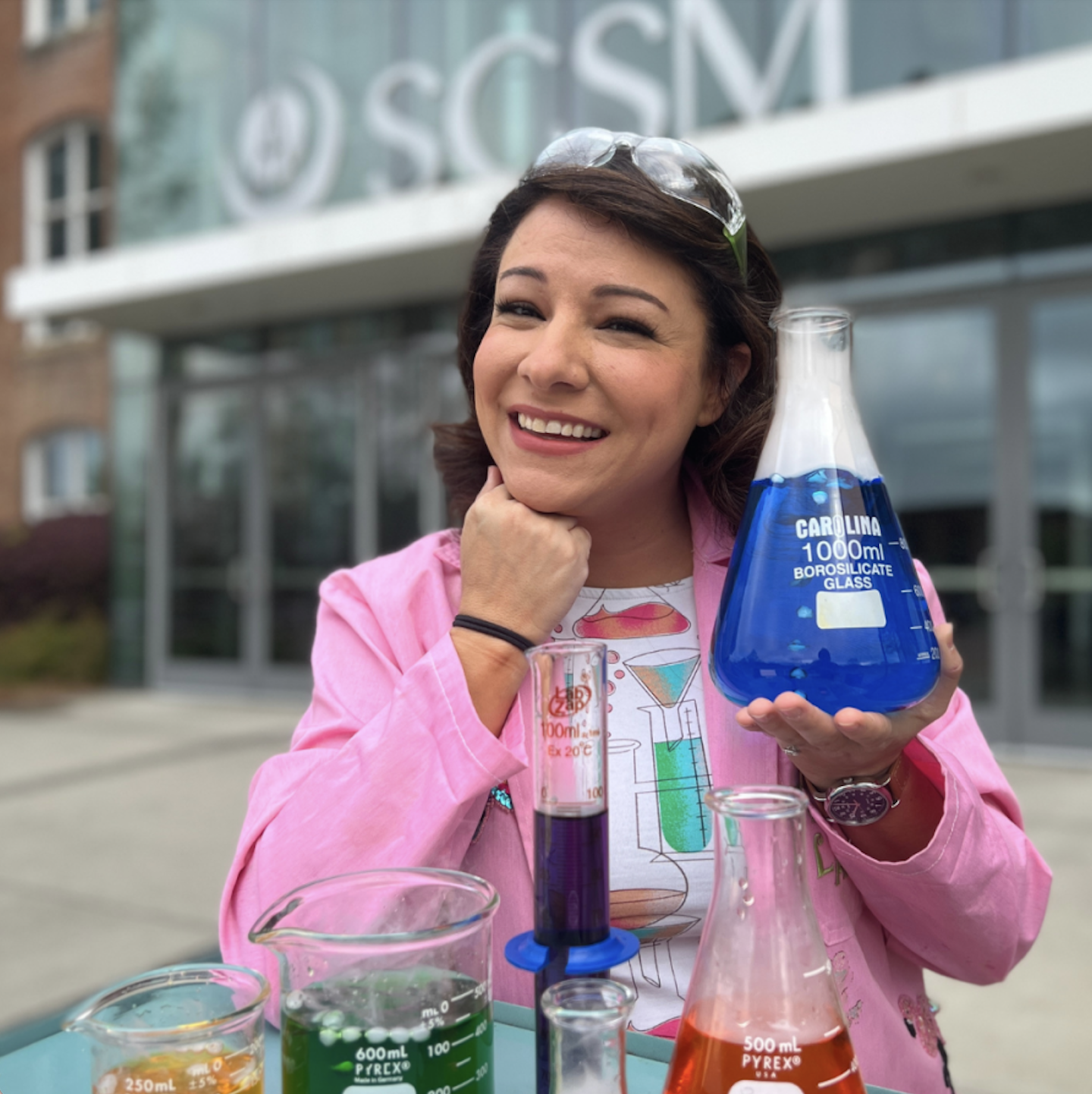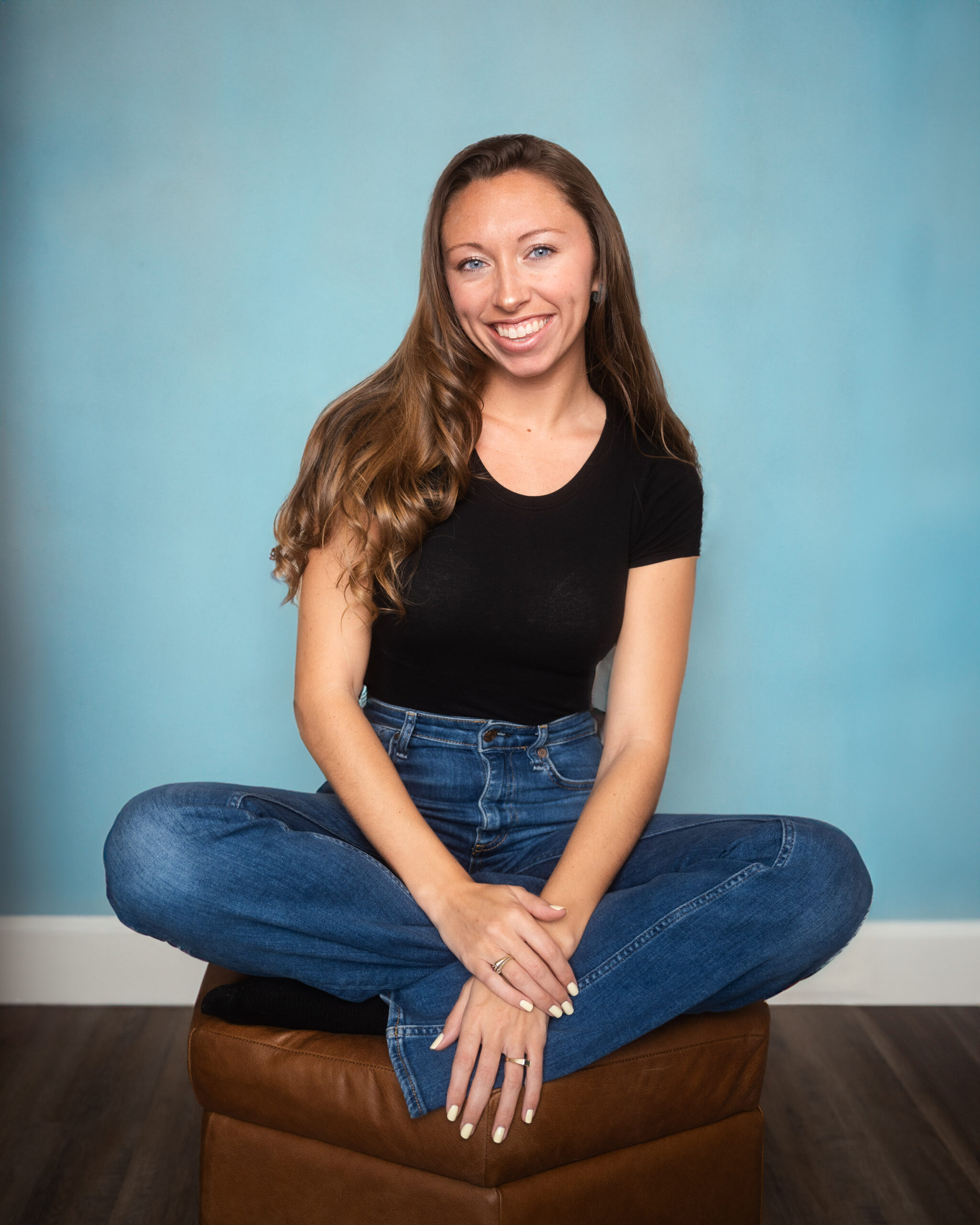“I gotta do the right fit for me, because ultimately I’m the one who’s got to show up and do it every day.”
Carol Baker is the Director of Outreach and Community Engagement at the South Carolina Governor’s School for the Arts and Humanities.
Interview
Transcript
Lexi Raines 00:02
Okay, so first, I’m just going to ask you to introduce yourself. What do you do for what do you do for work? And where are you currently working from?
Carol Baker 00:10
So I- My name is Carol Baker. I am the Director of Outreach and Community Engagement at the South Carolina Governor School for the Arts and Humanities.
Lexi Raines 00:20
That’s awesome. So how long have you been working there?
Carol Baker 00:23
Yeah, so I’ve been there since 2012 so my first school year, we think in school years a lot, was the 12-13 academic year.
Lexi Raines 00:31
Awesome. So what’s one thing that you love about working there, working as like a creative in South Carolina?
Carol Baker 00:41
So I- our school has a statewide mission, which is great, because that means I get to be in all kinds of different communities and all kinds of different places. What I love about South Carolina is I think there’s a really strong identity. So there’s a there’s there feels like there’s a strong statewide identity, for sure. And people who are from South Carolina are really proud of that, like, we’ve got some really amazing things here. But if you have a chance to go into all of these smaller towns, or medium sized towns, or, you know, urban, rural, we have such a wide range. And what you see in the upstate might look totally different from what you see in the low country, and it’s such a, I don’t know when you get to do community engagement work like that. It’s such a joy to get to see all of that and see the different creatives and creative people and the ways that different people approach their their sort of communication, and how they show up for themselves.
Lexi Raines 01:31
I completely agree. I feel like South Carolina is a very dynamic state, and yeah, that’s part of what we’re trying to showcase. So what do you think South Carolina brings to, like, your work? Like, does it have like, unique influences on you compared to being anywhere else?
Carol Baker 01:49
It does. You know, my job is kind of like a mix of things. So I do, I do community engagement, right? There’s building and working in communities. There’s arts education specialty, like I’m an arts education specialist, so that’s my field, that’s my area. And then there’s also just arts management, right? There’s leadership and understanding how to work in a budget and how to write a grant, and all of those things too. It’s kind of a nice mix of things. And one of the things I think South Carolina is really special in and really what it offers is unique- Is a very, very vibrant arts education community. So we have got strong arts education leadership. We’ve got bipartisan support. We have opportunities to advocate. We have opportunities to learn how to be better at our jobs. There’s an arts education community here that’s very It’s tight knit, it’s strong and it’s supportive. It’s, it’s, you know, not as competitive as you might see in other areas. So, and having sort of seen it from the outside, you know, especially when you travel, you go to other states, and they’re like, you have what? I’m like, yeah. So this whole ecosystem here that is really unique to South Carolina?
Lexi Raines 03:01
Yeah I feel like that is very important. Because I feel like the support that young creatives have, like, oftentimes rely on, like, their teachers and just their direct community around them. So yeah, I think that’s really awesome. Yeah, so how would you describe that local professional community?
Carol Baker 03:24
Yeah so for me, local is interesting work, because I have a state mission, and in many ways, my my professional community is actually a statewide community, and not just a local, you know, down the street or in my neighborhood, kind of professional community. What I see is support, which is amazing, people who are willing to cultivate leadership, which I think is important, but also a willingness to kind of allow people to do what they do best. So we have different people who do different things, and as a result, I don’t have to feel like I have to do everything, which is a great feeling. I know I can pick up the phone and call somebody in my professional community and ask for help, or ask for support, or say, hey, students were really kind of outside my my lane. Can I call on you to help? And the answer will be yes, because we have such a supportive community. So the other thing is, I think we’re a little bit of a bunch of misfits, which I think artists kind of are in a lot of ways. You know, there’s only one me. I’m the only one who does what I do. There’s only one person who does XYZ job over here and XYZ over job over there. And in order to, like, build community and have community like, you need to be able to have those individual kind of personalities and roles come together, because otherwise, I think you could feel pretty isolated. So it’s a very deliberate and purposeful community.
Lexi Raines 04:49
Yes, I feel like in like bigger cities such as like New York or Los Angeles, I feel like there is some type of community unity, but it’s, I feel like it’s definitely not as involved as the one that we have here. Because I feel like, at the end of the day, everyone there is trying to get ahead of each other, where here, I’ve heard this a lot through all my interviews, that everyone’s just wants to support each other and help each other out. So I think that’s absolutely awesome. Yeah. So how would you define professional or personal success in your creative endeavors or at your work?
Carol Baker 05:30
Yeah, so 97% of what I do is collaborative. I do very, very few things in a bubble, by myself in a vacuum. So for me, and this is going to sound maybe a little bit heady, but it actually, it actually is, the most crucial piece of it is trust. I have to know that people trust me, and I have to be able to trust other people. So for me, success is when that trust is cultivated and we have a relationship that is built around that. Because community, any kind of community work, whether it’s in the arts or any, you know, in, you know, hospital outreach, whatever community work you’re doing, you have to work with people. It. That’s the whole function of community, right? So when I when I have somebody pick up the phone and call me and say, Hey, I don’t know the answer to this, but I figured you either would know or could help me find the right person that shows that I have developed a trust relationship with that person or that community, and they know that they can call me and we’ll stand with them and figure it out. So that, to me, actually is probably the biggest sign of success.
Lexi Raines 06:37
Yeah, I completely agree. Trust is just so so so important. So you said you’re an arts education like, that’s like your main field. So what was your biggest fear when you decided to, like that you wanted to pursue the arts or being a arts education teacher? I feel like it can be, like, very scary.
Carol Baker 07:01
Yeah I think for me, and I probably still deal with this to a certain degree, is a little bit of imposter syndrome, and also some definite sense of there’s a very specific path you’re supposed to take with this certification and this type of degree and this type of educational outcome, right? Like and if you don’t have those boxes checked, then you’re not really a part of that field, right? And that’s actually not necessarily the case. I’m not a certified teacher, which is interesting. I have a teaching artist background and a management of education background. So when you look at these traditional paths and you kind of think, Oh, well, those people, they must know something I don’t know, or there’s they probably are better at something than I am. I think there, I think if there was a lot of reminding myself that there are other ways to go about doing things and still be a part of a community. So yeah, you know those traditional paths, they are critical. And I don’t, I do not say don’t do that. They’re fantastic. And also there are other ways as well. So it kind of takes, I think, a lot of different ways to approach a problem.
Lexi Raines 08:08
I completely agree that’s one of the main things that we want to do, is to show that there’s not just one set way to get somewhere as a creative there’s so many different paths. There’s people who went to school for something in STEM and then later decided to pursue the arts, right? It’s just such a dynamic range, and it changes all the time. So I definitely understand how it can be scary, but I feel like there is so much of that support here and people to lean on, yeah, so please, can you, like, describe a defining moment that you’ve had in your career?
Carol Baker 08:47
Sure. You know, I saw that question last night, and I was like, gosh, I feel like there’s a million, and I don’t even know how I would pick one, but I think, I think I would pick something that’s actually happening now that we started in 2016 but it’s important, because actually everything in my career path sort of led up to it, so I’m currently- so as the Outreach Director, we run a lot of different types of programs, right? We have, you know, just a wide range of things that you can kind of choose from, if you’re a teacher or an after school provider. One of the programs is called Spark, and it is a program that uses drama strategies to support literacy. So reading, writing, oral communication, all of that, primarily reading is what we’re mostly interested in, but getting kids up on their feet and using playful strategies and using creative strategies instead of that. Hey, not everybody wants to sit and read a book. I personally love to sit in read a book, but that’s me. I understand that that’s when you’re eight years old. You need to move your body and you get it, you need to physically embody and understand what’s happening. I could not have known that that was going to be an opportunity for me when I started this a million years ago. But what’s interesting is that if I look at my path, where. I started was and when folks asked me my art form, I started in story. I started in the development of story, of why and how people tell stories. You know, I started leaning into the management of these kinds of programs. How do you build them? How do you structure them? How do you find funding for them? What do people need? Data do people need in order to believe you and trust you, right? How do you work with teachers to, you know, provide professional development services and all of that, I didn’t, I didn’t and couldn’t, have known that this would be an opportunity for me. And yet, everything that I was doing was pointing me in that path. And so when I look at it, I’m like, “Oh my gosh”. Like, that’s exactly what I was supposed to be doing all along. I just didn’t know, and yet, now I’m in it. I’m like, Well, this is exactly what I’m supposed to be doing. This is where my choices led me. So I feel like as a defining moment, that’s an important piece to say, “Hey, I didn’t know I was going somewhere, but the things that I cared about and trusted enough to learn about led me to the right place”. That’s awesome. I feel like that is such a comforting feeling at the end of the day to look back and be like I was supposed to be here. My path led me to this. And I feel like that also goes back to what you’re saying about imposter syndrome, because, like, you got yourself here at the end of the day, like you- Right, exactly, right.
Lexi Raines 11:30
So also, can I ask you, what is the best and worst advice you’ve ever received?
Carol Baker 11:36
Yeah, so probably the best advice actually got two pieces of really good advice, but that would say the best advice for a community person and it was actually said, go to the kids. Always go to the kids. The idea was so I was, at that point, I was debating between working in more of an education setting or more of like an arts setting in education, like a performing arts center that has education programs, slightly different, dynamics, very similar, and either one would is they’re both great. But regardless of that, at that time, the advice was, don’t ever assume a child or a community member or a person that you’re working with is going to come to you. Your job is to go to them. It is to be in their community. It is to trust their decision making. It is to recognize what they need. It is not that they come into your space. And that advice was given to me specific about school kids. You know, we’re talking about school kids. Well, where do they go every day? They go to school every day. So like, how do we work with schools? Right? But it actually is true for any community, right? No matter what you’re doing, community driven work is about the other person. It’s not about you, it’s about what they need, what they’re asking for, what they’re assessing within their own situation, right? So I think that was the best advice I’ve never I can’t actually call up the worst advice, but I do have a thing that I think is probably falls in that category. I was very lucky. I grew up in a family of musicians and community service people, people who worked in nonprofits and arts and all this stuff. So in some ways, what I do makes complete sense, right product of my environment. Not everybody has that, you know, experience. But what was interesting to me was the expectation so they were musicians. The the expectation was that I would go into music. That was just it. There was no question about it. It was never said. It was never even a thing. It was just kind of, well, that’s what’s going to happen. It was almost like a the world around me had just decided this for me, right? Yeah, I spent a lot of time in my early adult years really trying to figure out the difference between what other people expected from me and what I needed for myself creatively. That was never going to be my gig. It doesn’t mean I don’t love it, because I do. I’m actually interested in all the arts, but especially interested in all the performing arts. Very interested in stories. I’m very interested in how we embody stories, right? So if I had sort of allowed that sort of wave to direct where I was going, I wouldn’t be as happy as I am. And so I think there is a necessity to evaluate yourself and your own needs as well as what’s actually available to you, right? Like, because I was, again, I was looking at parents who were like, That’s cool. Go a different direction. That’s fine. The community at large, that was actually also kind of interesting, because people knew who we were, and there was an expectation that, oh, she said, I probably do that. That was not the right thing for me. And so I say that, to say that there are social expectations and social dynamics that we all face, regardless of what they are, whether you want to be a musician or chiropractor or whatever it’s still, there’s a certain. Level of I got to do the right fit for me, because this is, ultimately, I’m the one every who’s got to show up and do it every day at the end of the day. So I think that was, I wouldn’t say it’s bad advice, but it was almost like a very quiet assumption that had to be pushed against.
Lexi Raines 15:16
Yeah, and I feel like there’s a lot of things that are true for like, a lot of students like that, like, I know, for me personally, I came into school with a computer science degree because kind of growing up, my whole family was like, you can do anything, but don’t do anything in the arts because you’ll never make money. So and I feel like that’s how it is for, like, so many students everywhere. And then I was miserable in that, like, so miserable because, like, that’s just not what I wanted to do. That’s what other people wanted me to do. Wasn’t what I wanted to do. And so I ended up switching to English, and I’m, like, significantly, significantly happier. Like, I’ve never missed computer science a day in my life, right, right? So I when I ended up telling my mom she was okay with it, because she was like, at the end of the day, it’s, it’s your life. But I feel like just having any ounce of support is from your family, from a community, is so, so important.
Carol Baker 16:20
Yeah, yeah, yeah. One of the things when I was trying to decide my degree, I’m also an English I had an English major and did some arts management as well. Never heard of arts management. I just fell into it as an elective at school, because I was interested in writing and publishing and, you know, the arts and all this kind of stuff. But I remember my dad was told me one time. He was like, you know, what do you not want to do? Let’s focus on that first. Get that out of the way so that we don’t end up accidentally doing something that sounds horrible, right? Like, sometimes you don’t know what you do want to do, but you definitely know what you don’t want to do. Yes, which I thought was another, another good piece of advice.
Lexi Raines 16:57
So I completely agree that’s, that’s something really good to go off of, yeah. Okay, so can you walk me through a typical work day?
Carol Baker 17:08
Yeah, I can do my best. So a typical work day for me? Actually, one of the joys of this job is that I don’t have a super typical work day, which I love. Like each day could look different than it did the day before, but the kind of broad strokes things that are generally expected of me during a day, we have a lot of public facing documents. There’s a good bit of reading, writing and editing that has to happen, making sure that you know, you don’t accidentally say 2004 instead of 2024 which may or may not have happened to me just last week and a document, there’s also a lot of advocacy work that gets done, so whether that’s internally within my own leadership team, and I have amazing support here, so that’s not a huge thing, but there’s just a reminder of what does it mean to be a community person, like an explanation of, sort of the back end, that these things don’t magically happen Every day. There’s budgets that have to go behind them. There’s, you know, procurement and purchasing that has to happen. There are rules about what you can and cannot do in a public school that I’m responsible for making sure that my team follows. You know, do we have media releases on this kit these kids before we take photos of them? So a lot of the stuff that I do is actually an ef- in and done in an effort to make sure that my teaching artists, who work for me can actually teach so they focus on the teaching. My job is to say, Do you have the right lesson plan in place? Do you understand what you know? Have we aligned this appropriately with the standard so that the teacher that you’re visiting will have a quality lesson and a quality experience. Do we need to go explore a grant option and make sure that we have written that correctly so that a donor and we’re gathering the right data for that donor? So there’s a lot of back end work that happens. There’s also a good bit of travel that happens as well. That’s a part of the job. And I remember during COVID, I was like, a community director is meant to be in their community. So there’s just being out with people and in their, you know, local restaurants or their schools or their after school clubs is a big part of it as well. Yeah, that
Lexi Raines 19:17
sounds very busy, but it sounds like very, very engaging. That is what we do, community engagement. But I feel like it sounds just so interesting to always be out there in the community see what’s going on. So that’s awesome. Yeah. What are some habits that you have that you think would be beneficial for others wanting to join your field?
Carol Baker 19:42
I think one of the things that’s super important is a very clear awareness of yourself and how you function, because the this type of job can wear you out really fast. You spend a lot of time in the car, you spend a lot of time in hotels, you spend a lot of time in other people’s environments and that also is- Goes to your creativity practice as well, right? Like, if you’re going to maintain boundaries and all of those things, you need to know yourself well enough to know I probably can’t actually drive that far and what, even though I could five years ago, maybe I can’t do that now. Or I need to make sure I stay in a hotel that has this kind of situation, right? Like those personal boundaries have to actually really be strong and in place if you’re going to be in a position where you’re constantly giving and putting out. Because if you don’t do that, you’re just going to run yourself run yourself ragged. And I think the other piece is really knowing what you can and cannot provide. You know, we have folks, and be clear about that. You know, we have folks who will call. We don’t have this as much now, but when we were first kind of trying to decide on some things, outreach can look and community engagement can look like. So many things, there’s a million ways to do it, and they’re all great like that doesn’t mean one is better than the other, but you have within your capacity, whether it’s budget wise, staffing wise, just human capacity right to show up for you have what you have. So if you if somebody calls and asks for one thing and you can’t meet that need, it’s actually okay to say, I love that you have that need I can’t meet it, but let me help you find someone who can, because you’ll just end up being like, Oh no, this person needs something, and this person needs something, and you have to have pretty clear professional and personal boundaries. I would say boundaries, I think is the biggest, the biggest answer to that probably.
Lexi Raines 21:36
Yeah, I I completely, complete. I feel like that’s an amazing piece of advice, because I feel like so many people do struggle with setting those boundaries. So is that like, how you would say you created your like, work life balance?
Carol Baker 21:52
Yeah, in a lot of ways, and I think also, you know, for me and this, this might look different depending on the kind of artists or creative that you are. I consider myself more of a creative than an artist, but artist, but I’m more interested in the process than I am in the product. So I’m not the type of person who’s that worried about getting my thing that I’ve done, my piece that I’ve written, or whatever, exactly right? Because I’m not that interested in putting it out so that 20,000 people listen to it. I do it more for myself and my own sort of creative expression and my own mental health and well being and personal curiosity, right? That means that I’m more flexible. I can do it more places. I don’t have to. I’m not tied to a rehearsal that’s happening at the theater down the street or whatever, right? So that’s that’s unique to me. And some people are like that. Some people are in the other direction. That’s totally cool. One of the things I think that’s fun about this job, though, is that you get to go into all these communities, and you get to participate in their cultural stuff, which is fantastic. So you get your needs met in a lot of ways, because you’re exploring the culture. You can go to the local museum while you’re in Barnwell. You can go to the local art festival while you’re in Georgetown, right? You can do those things because you’re there, and that’s actually part of your job, which is fabulous, right? So I would say that a lot of it is taking advantage of what’s immediately in front of you, in terms of your creative outlets, practices, things that you want to explore. You know, there is nothing wrong with a great night in a hotel room working on crafting a piece of something that you might not even do at home. Because when you’re at home, you’re like, how do the dishes, right? Like, it’s kind of, I don’t know, it’s kind of nice to kind of have an escape to a certain degree.
Lexi Raines 23:34
Yeah, that’s a really, yes. That’s a really, like, fun and interesting mindset that like, I haven’t really heard heard of a lot, but I feel like that’s definitely a good thing to keep in mind when you are traveling so much and it’s for work. Why when you work creatively, why not find stuff to do within what you’re already doing? So Right? I feel like that is an amazing mindset to have so almost my last question, so, do you have, like, any questions that you wish you were asked?
Carol Baker 24:12
I think the one thing I would say, I don’t know if it’s a question, but I think the one thing that would say is that it’s okay if you are not a specific artist within a specific area. So, like, if you’re not an assistant block yet, I’m trying to think of an example. But if you’re not an oboe player, right? Like, and you have this very clear defined thing, I’m an oboe player. This is what I am. It’s okay if you’re not that, it’s okay to say, I love all of the arts. I love all of maybe I don’t love all of the arts. Maybe I love everything that has to do the writing. Or maybe I love everything that has to do with the performing arts. Or, oh my gosh, I I just love three different things, right? Like, I think this idea that an artist and a creative has to be. Assigned to a specific thing is, is good. There’s nothing wrong with it. There’s plenty of people who do that. I work in a school that supports that, so I want to be really clear, like, even my school here, that’s what we do for kids, is we’re like, that’s your passion. Let me help you go deep with that. Not everybody’s going to do that. Some people will also be in the broader sort of multi art kind of domain, or the hyphenate artist, or whatever it is that you’re considering. That’s also great too. There are plenty of roles for that. I think I may have mentioned this earlier, but when I first started working, I people would ask me my art form, and I’d say, “Well, you know, primarily drama, but really it’s story”. And that was, that was, that was a thing people be like, when you type what? That doesn’t fall in the box, right? But it actually is the connecting piece between all the art forms that I’m interested in. I’m interested in how artists and creatives tell stories. So it’s, I think it’s one of those things to remember that all of those things are important, right? It’s a pie. It’s a puzzle. We need those deep dive people in order to be in the symphony, and we need those deep dive people to make beautiful pieces of photography or whatever. And also we need other people who can help pull it all together from sort of a different perspective. So we just toss that out there.
Lexi Raines 26:22
No, I can- I completely agree with that. I feel like also, when you are just you’re only limiting yourself to one thing, I feel like you can, kind of like hinder yourself from other opportunities or other things you might end up loving even more than you love one thing so and I feel like I feel like interdisciplinary artists are definitely growing in popularity, because people are finally realizing, “oh, I can do everything I want to everything that I love. I don’t just have to market myself towards one thing” which is absolutely awesome.
Carol Baker 26:59
You know, I’ve actually most of the folks, when I was kind of coming along, were exceptionally skilled in multiple art forms. I mean, it was mind boggling to me, and I was like, Oh, you’re actually an artist. Like, that’s here. Let’s zoom up and talk about it as, like an artist versus this or that and I don’t- and again, I those that does not mean that those other things aren’t valuable. It means that we need all of them, and if we just focus on one or we just focus on the other, then we’re missing the point, right? But I love the term creative. I love the idea of the creative as a type of individual, right? Like it just kind of kind of shakes it out a little bit and gives you some room to breathe. If that is the right place for you to be.
Lexi Raines 27:44
I completely, I completely agree with that. So my last question for you is, do you have a creative or an artist that you would like to nominate to be interviewed?
Carol Baker 27:57
I do actually have two. Can I nominate 2? Am I allowed to do that?
Lexi Raines 27:59
Yeah, let me get a pen and paper.
Carol Baker 28:02
They’re both affiliated with the Governor’s School, so I don’t know if that is I don’t know how you make your decisions about who you choose, but-
Lexi Raines 28:08
Okay, I’m ready.
Carol Baker 28:10
So the first one is Dr Cedric Adderly, C, E, D, R, I, C, A, D, E, R, L, E, Y. He’s the Governor School’s president, and he is also a so he’s an educator, but also a composer. And, you know, just has a really cool, interesting story and dynamic to tell the others. Anne Tretromsness: TR and with an E, and then T, R, O, M, S, N, E, S, S, to look up at the sky, to follow the letters. How do I spell that?
Lexi Raines 28:45
Okay, so wait, S N, what is that?
Carol Baker 28:50
Yeah, so it’s, let’s start the beginning, T, R, O,M, S N, as in no, E, S, S, Tromsness.
Lexi Raines 29:01
Okay awesome.
Carol Baker 29:02
Yeah, she is on our faculty here, but she’s been an educator in lots of different settings, but she’s also an active director and active performer, very much into social justice type movements. Just a really all around interesting. She was Teacher of the Year for Greenville County. I think they both have just really nice, interesting stories. I think, yeah, what you’re looking for, I don’t know what you’re looking for, but I don’t even know how I ended up here. So there you go. How does this happen? So, yeah
Lexi Raines 29:33
Yeah so you were nominated. I could, could probably pull up who you were nominated by, actually, because we can tell you. You were nominated by Thurraya.
Carol Baker 29:45
Oh, okay, great, yes.
Lexi Raines 29:46
And then we also actually do have Dr Cedric on or Dr Adderley on our nominations list.
Carol Baker 29:54
So I figured he probably, I think I have actually nominated him before in some other capacity, so that’s good. Yes. So they’re very different individuals from each other, but, you know, they’ve got really great stories. Yeah,
Lexi Raines 30:05
That’s awesome. So I’m going to be sending you a follow up email eventually, if, in that email, I’ll also ask in there you could connect like Ann’s email, because we already have Dr Adderley’s email, okay, just so that we can look into her a little bit more and put her on our list to reach out to.
Carol Baker 30:31
Yeah, absolutely.
Lexi Raines 30:32
Thank you so much for your time.
Carol Baker 30:34
Yes!
Lexi Raines 30:34
I loved interviewing you, its really awesome, and-
Carol Baker 30:37
I’m glad good time too. So thank you.
Lexi Raines 30:39
Thank you. Have a good day.
Carol Baker 30:41
You too. Bye.
